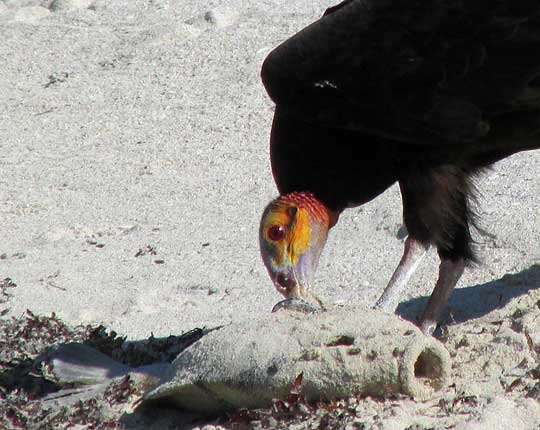
Energy enables living things to move about, and some of us forms of life to think and feel. To visualize the relationship between energy and Life on Earth, it's useful to know about trophic levels.
TROPHIC LEVELS
One way of viewing the photo at the right is to say that it's a Lesser Yellow-headed Vulture, Cathartes burrovianus, eating a fish. Another perspective is that the picture shows energy being transferred from one trophic level to another.
In the vulture picture, energy is passing from the trophic level comprising top predators in a lake, to the trophic level of terrestrial scavengers.

Sunlight energy flooding onto the Earth was captured through the process of photosynthesis by algae and other organisms in the fish's water, then those photosynthesizing organisms were eaten by larger animals such as shrimp who took some of that energy into their own bodies, and then those shrimp and other animals were eaten by the fish in the picture, in whose body some of that energy was stored, and now the vulture is taking into his body some of that same energy. When the vulture defecates, some of that energy will be further shared, perhaps by decomposition microorganisms in the soil or water.
ENERGY MOVES ABOUT
Energy in Nature always is moving from place to place. We humans take energy into our bodies when we eat. In contrast, energy leaves our bodies in various ways. Here are the main pathways:
 infrared picture of half a cup of cold smoothie; picture courtesy of Mark Taylor & Wikimedia Commons
infrared picture of half a cup of cold smoothie; picture courtesy of Mark Taylor & Wikimedia Commons- Under normal conditions about 65% of our bodies' heat energy is lost through radiation -- evaporation of water from the skin, or, like all bodies with temperatures above absolute zero, as escaping heat. Some heat is loss as infrared light. At the right, a picture of a glass half filled with cold liquid, when viewed in the infrared light spectrum, shows radiated heat energy as a lighter color, cold as darker. Note the temperature scale at the picture's right.
- Energy passes from prey to predator, as when squirrels are eaten by hawks, or when humans eat cows (perhaps in the form of hamburgers).
- When we defecate, energy departs in undigested matter, as well as in the bodies of a wide variety of microorganisms who assist with digestion, and leave our bodies with the poop.
- Some of our bodies' energy is taken into the bodies of parasites such as fleas and intestinal worms.
- When we die and decay, our energy passes into decomposition microbes, or else when the bonds between atoms and molecules in our decomposing bodies are broken, heat is lost as radiated energy.

DEFINITIONS
If we refer to the sequence of organisms through which energy passes as food, we're speaking of a food chain. If we describe the various alternative routes, short-cuts, diversions, and recyclings that energy is capable of as it circulates through the ecosystem as food, we're referring to the food web. Vegetarian deer and squirrels in the forest, or cattle in the field -- the first to use the green plants' stored energy -- are primary consumers. Carnivores, parasites, and scavengers that ultimately eat the deer, squirrels, or cows, are secondary consumers
THE SECOND LAW OF THERMODYNAMICS
The Second Law of Thermodynamics states that every energy transformation involves a loss of usable energy. This is certainly the case when energy passes between trophic levels, as when a predator like a hawk or a meat-eating human, eats a primary-consumer vegetarian.
In Eugene Odem's classic 1953 textbook Fundamentals of Ecology it's stated that during the course of a year 20,000,000 alfalfa plants weighing 17,850 pounds (8097kg) are needed to fuel 4.5 cows weighing 2,250 pounds (1021kg), which will satisfy the energy needs of a single 105-pound (48kg) boy. Here we plainly see energy being lost at each change of trophic level.
The ethical questions raised by these facts are worth thinking about. By "eating lower on the food chain," vegetarians require much less land for the production of their food than meat eaters, even though vegetarians and meat eaters require the same amount of energy for staying alive. If you're curious about vegetarianism, you might check out the Vegetarianism in a Nutshell pages on the Internet.